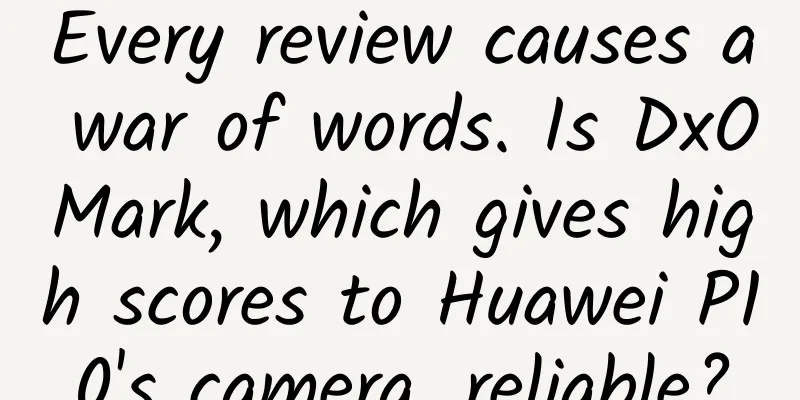Every review causes a war of words. Is DxOMark, which gives high scores to Huawei P10's camera, reliable?

|
Yesterday, the famous camera evaluation organization DxOMark released the camera evaluation results of Huawei's new flagship P10. In the end, the score of Huawei P10 was fixed at 87 points. This result tied for third place with Moto Z Force Droid, Samsung Galaxy S6 Edge Plus, Sony Xperia XZ and Sony Xperia Z5, defeating classic models such as iPhone 7. However, the focus of our article today is not on the camera performance of Huawei P10, but DxOMark. Like every previous evaluation, DxOMark's score has once again been criticized by netizens. Many people think that DxOMark's evaluation no longer has credibility. Why can Sony, which does not perform well in photography, dominate the list? Why shouldn't models such as Huawei P10 and iPhone 7 be ranked in the top few? Even the saying that DxOMark takes money has emerged, and there was a lot of saliva flying around. So how does DxOMark do the evaluation? Will it collect kickbacks from manufacturers? How did those results in the evaluation that are far from our usual cognition come about? DxOMark was founded in 2003 and has always been committed to professional camera and lens evaluation, but in recent years it has also started to evaluate mobile phone photography. On their website, we can see their definition of themselves: Objective, Independent, Comprehensive, which means objective, independent and comprehensive. So why does DxOMark still have so many "controversial penalties"? This requires talking about their "rigid" evaluation method. In order to achieve the most accurate evaluation data, DxOMark's laboratory is covered with matte materials, the temperature is controlled at 21-25 degrees, the humidity is between 30-70%, and the on-site light source has even been corrected for color temperature using spectral equipment to strictly control the entire test environment. And they don't use the naked eye to make horizontal and vertical comparisons, but use professional equipment to read out the various data of the RAW format photo file, and then calculate the score of a certain aspect according to the relevant formula. Look at the calculation formula of the signal-to-noise ratio below. Are you dumbfounded? And it is precisely because of DxOMark's testing method that only looks at data and not actual performance that the actual perception may be different from the test results. For example, there is a similar "shortcoming" in the camera testing standard: DxOMark scores according to Print points (scores after compression to a certain size) in the sensitivity test, and this algorithm is more advantageous for high-pixel models! In addition to Print points, there are actually testing methods such as Screen points.There are Screen and Print options in the upper right corner. Can we also infer from this point whether the same tendency will appear on mobile phones? Will the DxOMark algorithm be biased towards Sony's mobile phones? In addition, in the test of Artifacts, a problem of image quality degradation, the Artifacts scores of many old models are far better than those of new models, which makes us have to doubt that for metaphysical issues such as image quality, can data really completely replace the observation of the eyes? In addition, many mobile phones cannot output RAW. Each sample is the product of the joint influence of the lens, CMOS, ISP, and algorithm. Later, there are a series of changes such as HDR, dynamic range improvement, noise reduction, multi-frame synthesis, and even color adjustment. In this case, DxOMark still uses a specific scoring method to test, which seems objective, but it is actually the most subjective approach. The best proof is that DxOMark cannot provide specific standards, reference documents, and original test data for mobile phone testing. This is where DxOMark's advantage as a camera evaluation agency comes into play. Professional photographers only look at RAW and not JPG. Few people use in-camera filters, multi-frame synthesis and other functions when taking photos, because only good RAW files can give them more room for post-production adjustments. I think it may be because the test content previously catered too much to the needs of professional photographers that DxOMark is not suitable for mobile phone testing! The importance of RAW for post-production. Finally, video shooting is also given a relatively heavy weight in the DxOMark test, and the scores of mobile phones with good video are relatively high. The focus test and anti-shake test are also full of doubts. For example, in the focus test, the focus score of the Samsung S5 with phase focus is far lower than that of the S4. And when we generally use the automatic mode to take pictures, DxOMark uses the full manual mode for testing. Don’t you think this is a special treatment for Sony? So if you want to define the DxOMark score, in terms of absolute image quality, although the DxOMark score has an inexplicable tendency, it still has a very strong reference significance. Some pictures are really only taken well by the first place, and the second place is really not good. Some photos can only be seen clearly by those few mobile phones when they are enlarged to 100%. However, in our daily use, we should compare the sample photos horizontally and vertically, and try out the camera experience of the phone ourselves, then we can choose the phone that suits us best. Sometimes we really can't easily equate high scores with high quality, just like we said when we were in school: the person with the best test scores is not necessarily the best in the class. As a winner of Toutiao's Qingyun Plan and Baijiahao's Bai+ Plan, the 2019 Baidu Digital Author of the Year, the Baijiahao's Most Popular Author in the Technology Field, the 2019 Sogou Technology and Culture Author, and the 2021 Baijiahao Quarterly Influential Creator, he has won many awards, including the 2013 Sohu Best Industry Media Person, the 2015 China New Media Entrepreneurship Competition Beijing Third Place, the 2015 Guangmang Experience Award, the 2015 China New Media Entrepreneurship Competition Finals Third Place, and the 2018 Baidu Dynamic Annual Powerful Celebrity. |
>>: "Unlimited" data usage is just a gimmick, and it's too early to say Wi-Fi is obsolete
Recommend
Olympic ratings plummet: Will NBC's tragedy happen again in China four years later?
With the official end of the Olympic Games on Aug...
Huangnan Aquatic Products Mini Program Franchise Price Query, How much is the Huangnan Aquatic Products Mini Program Franchise Price?
Why join the WeChat Mini Program Development Comp...
Reviewing the history of interactive design: returning to humanity and regaining simplicity
[[127848]] The development history of human-compu...
Cao Cao, “a capable minister in peaceful times and a hero in troubled times,” died of what disease?
The Yangtze River flows eastward, and the waves w...
Don’t rush to “take action” even if you are “inspired”. Patients with heart disease should be cautious when traveling during the short holiday.
Written by Shi Shutian (Deputy Chief Physician, D...
Toutiao’s addictive data mining
Due to some irresistible forces, Toutiao 's p...
The iPhone is not immune: The smartphone industry has officially become “PC-ized”
2018 is coming to an end. A lot of things happene...
Comparison of the latest shipments of Android and iPhone to see their system market share
Recently, the statistics agency Statista released...
Exploring the potential and challenges of developing games for Apple Watch
The developers of the first Apple Watch game are ...
When technology meets archaeology: Reconstructing shell paintings from more than 2,000 years ago
Produced by: Science Popularization China Author:...
Do user needs really need to be met?
"Users say they want this feature, why haven...
Jiuquan WeChat ordering software mini program, how much does the WeChat mini program for ordering food cost?
Everyone is familiar with WeChat mini-programs . ...
Tsavorite: The new noble green gemstone
introduction Starting today, the "Treasures ...
I have no regrets about joining China! Today, listen to the voices of Chinese scientists joining the Party
"I volunteer to join the Communist Party of ...
Eight "traps" to avoid in the programmer profession
[[229123]] Let's face it. Some of you got int...








![[Collection] 203 practical tools recommended, a must-have for operators, designers, and advertisers!](/upload/images/67cc3c136c786.webp)
